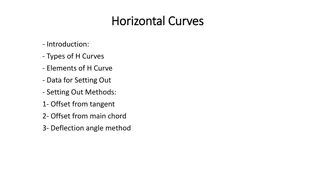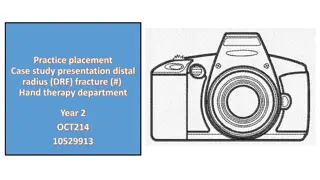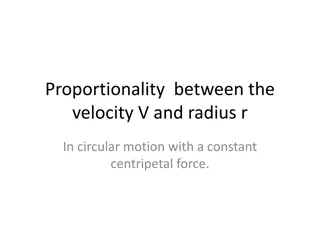Understanding How to Read a Load Chart for a 100-ton Crane
Load charts are essential for determining safe lifting capacities of cranes in construction and heavy machinery operations. This guide explains how to interpret load charts based on factors like boom length, operating radius, and load weight, ensuring safe and efficient crane operations. Learn to id
5 views • 7 slides
Periodic Law and the Periodic Table
The Periodic Law dictates the predictable patterns in physical and chemical properties of elements when arranged by atomic number. The discovery and impact of the Periodic Law, along with the properties it affects like atomic radius, ionization energy, electronegativity, and more, are essential in u
8 views • 12 slides
Looking for the best Mobile Car Detailing in Taplow
Fizzy\u2019s Mobile Car Detailing, based in Taplow, brings exceptional car care directly to you. They provide the best Mobile Car Detailing in Taplow. Specializing in comprehensive detailing services, their family-run business covers a 25-mile radius, offering convenience and top-notch quality right
0 views • 6 slides
Techniques of External Fracture Fixation in Veterinary Surgery
Dr. Archana Kumari, Asst. Professor and Junior Scientist in Veterinary Surgery and Radiology, presents various methods of external fracture fixation such as Robert Jones bandage, Ehmer sling, plaster cast, Thomas splints, walking cast, and hanging pin cast. The walking cast is indicated for fracture
1 views • 22 slides
Distal Radius Fracture Surgery Patient Information
A distal radius fracture, commonly known as a wrist fracture, is a break in the radius bone near the wrist joint. Surgery may be necessary to realign and stabilize the bone to prevent complications such as stiffness, weakness, and pain. After surgery, patients should watch out for signs of infection
0 views • 4 slides
Understanding Orbits and Motion in Astrophysics
Explore the concept of orbits and motion in astrophysics, covering gravitational forces, planetary orbits, orbital speeds, and celestial phenomena like lunar eclipses. Delve into how objects move in space, the relationships between orbital speed, radius, and time period, and the dynamics of celestia
0 views • 14 slides
Understanding Horizontal Curves in Road Design
Horizontal curves are essential in road design to safely change alignment or slope. This article covers types of horizontal curves, setting out methods, geometric shapes of curves, and elements such as PI point, PC point, and radius. Learn why curves are crucial for modern highways and how different
0 views • 25 slides
Importance of Transport System in Animals for Oxygen Supply
Animals require a transport system to meet tissue oxygen demands efficiently. The size limit for oxygen diffusion alone is around 1 mm due to the proportional increase in radius and diffusion properties. Blood is crucial for transporting oxygen, nutrients, waste products, cells, and heat, as well as
0 views • 17 slides
Exploring Circles and Tangents in Geometry
Journey through the world of circles, exploring special segments, lines, and properties like radius, chord, diameter, secant, and tangent. Dive into the intersections and relationships of circles, lines, and segments to deepen your understanding of geometric concepts.
1 views • 49 slides
Understanding White Dwarf Stars: A Stellar Phenomenon
White dwarf stars are the remnants of burned-out stars, with cores composed of carbon and oxygen. They have various sizes and densities, with the mass of the sun but a radius similar to Earth. These celestial objects showcase the fascinating evolution and gravitational forces in the universe.
0 views • 8 slides
Understanding Rotational Motion in Physics
Explore key concepts in rotational motion through common scenarios like a point on a bicycle tire, determining centripetal forces in roller coasters, and understanding the forces at play in loops. Discover the relationship between mass, radius, and centripetal force, as well as the forces involved a
1 views • 23 slides
Chemistry Practice Problems Solutions Unit 4
The solutions to practice problems in Unit 4 cover topics such as atomic radius comparisons, electron configurations, halogen characteristics, isoelectronic species, and electron behavior in atoms like Na and Ne. Detailed explanations and answers are provided for each question to help understand and
1 views • 61 slides
Understanding Atomic Properties and Covalent Radii in Chemistry
Exploring the concept of atomic properties including the sizes of atoms and ions, the three common operational radius concepts (covalent, crystal, and van der Waals), and the calculation of covalent radius for homonuclear and heteronuclear diatomic molecules. This overview delves into the significan
1 views • 10 slides
Anatomy of the Upper Limb: Clavicle, Scapula, Humerus
The upper limb anatomy includes detailed descriptions of the clavicle, scapula, and humerus bones. The clavicle is a long bone that articulates with the sternum and scapula, while the scapula lies on the posterior chest wall and has important bony landmarks like the acromion and glenoid cavity. The
2 views • 15 slides
Anatomy of the Ox Radius: Structure and Function
The radius of an ox is the larger and shorter bone of the forearm, situated between the elbow and carpal joints. It consists of a shaft with distinct surfaces and borders, facilitating muscle attachments and joint movements in the forelimb. The proximal extremity articulates with the humerus, while
0 views • 11 slides
Enhancing Eduroam Security with New Standards and Practices
Explore the foundations of eduroam and the challenges with RADIUS, along with recommendations for improving security. Learn why moving away from RADIUS/UDP and adopting shared secrets of 16 characters is essential. Discover the issues with transitioning from UDP to RADIUS/TLS, and the new standards
0 views • 12 slides
Magnetic Field Problems: Protons, Wires, and Charged Ions
Solve various problems related to magnetic fields, including determining forces on protons, calculating magnetic forces on wires with currents, finding the radius of paths for charged ions in magnetic fields, and more. Understand concepts such as magnetic forces, circular orbits, and interactions be
0 views • 10 slides
Understanding the Periodic Table and Element Classification
The provided content discusses the development of the periodic table, periodic trends, and the classification of elements into metals, nonmetals, and metalloids. It covers key concepts like atomic radius, ionization energy, and properties of each element category, providing a comprehensive overview
1 views • 19 slides
Area of a Circle: Understanding Formulas and Calculations
Learn all about calculating the area of a circle, including the formulas for radius and diameter, the significance of Pi, and examples to help you grasp the concept clearly. From understanding the circumference to using the formula to find the area, this information-packed resource will guide you th
0 views • 11 slides
Mechanisms and Models of Nuclear Reactions
The chapter discusses the reaction cross-section in nuclear reactions, including resonance and tunneling phenomena. It explains the probability of reactions occurring, the influence of nuclear radius on cross-section, and how tunneling allows reactions at energies lower than the Coulomb barrier. Exa
0 views • 22 slides
Understanding Periodic Trends: Atomic Radius and Ionization Energy
The Periodic Table displays a systematic organization of elements based on their increasing atomic number, leading to periodic patterns in their physical and chemical properties. Key trends like Atomic Radius and Ionization Energy provide insights into the size of atoms and the energy required to re
1 views • 13 slides
Understanding the Anatomy of the Wrist Complex
The wrist complex consists of the radiocarpal joint and midcarpal joint, formed by various bones and ligaments. The radiocarpal joint involves the radius, radioulnar disc, scaphoid, lunate, and triquetral bones. In a neutral position, the ulna does not participate in this joint. The midcarpal joint
0 views • 16 slides
LUDO Modelling Project Work 2 with Supervisors Tamaga Istv.n, Pataki Peter, and Lala Ahmadova
This semester's goal is to enhance the previous algorithm to detect center points in a playfield and detect dice using simple image processing tools and Haar Cascade. Tools used include OpenCv/Python, Hough Circle Transformation, and Shape functions. The Hough Circles function in OpenCV is utilized
0 views • 16 slides
Nuclear Physics Research Highlights: Neutron Stars, Nuclear EOS, and Pb Isotope Studies
Explore cutting-edge research in nuclear physics, including experiments on pion ratios and Pb isotope radius measurements, neutron star observations, neutron density distributions of Pb isotopes, and polarized proton beams at Osaka University. Learn about the analysis of realistic point proton densi
0 views • 26 slides
Understanding Radians: Developing Unit Circle Skills
Exploring radians as a unit of angle measurement and honing unit circle skills through practical examples. Learn how to evaluate angles using the unit circle effectively. Dive into the fundamentals of central angles and their relationship to the radius of a circle for a comprehensive understanding o
0 views • 7 slides
Understanding Radians: A Challenge in Measurement Units
Explore the concept of radians as a unit for measuring angles through challenges involving arc lengths, radius comparisons, and conversions to degrees. Dive into a word search activity to test your knowledge and understanding of radians vs. degrees.
1 views • 9 slides
Code Assignment for Deduction of Radius Parameter (r0) in Odd-A and Odd-Odd Nuclei
This code assignment focuses on deducing the radius parameter (r0) for Odd-A and Odd-Odd nuclei by utilizing even-even radii data from 1998Ak04 input. Developed by Sukhjeet Singh and Balraj Singh, the code utilizes a specific deduction procedure to calculate radius parameters for nuclei falling with
1 views • 12 slides
Occupational Therapy Management of Distal Radius Fracture in Hand Therapy Department
Occupational therapists play a crucial role in the non-surgical management of hand disorders and physical injuries, such as distal radius fractures. They focus on restoring hand function, motivating patients to exercise independently, providing holistic support, and facilitating scar management. Usi
2 views • 19 slides
Cherenkov Ring Radius Determination from Modular Rich Detector Simulation
Explore the process of obtaining the Cherenkov ring radius using Circular Hough Transform in a modular rich detector simulation. The study, conducted by Cheuk-Ping Wong from Georgia State University, delves into Monte Carlo results, ring finder algorithms, event displays, and radius distributions in
0 views • 20 slides
Distal Radius Fracture: Diagnosis, Management, and Complications
Distal radius fractures, particularly Colles fractures, are common injuries, often affecting elderly women due to osteoporosis. These fractures typically result from a fall onto an outstretched hand, causing dorsal and sometimes radial displacement of the distal radius fragment. Clinical features in
0 views • 32 slides
Understanding Light Scattering Part 2: Solute Characteristics and Applications
Light scattering can provide valuable insights into solute characteristics such as molecular weight, radius of gyration, and second virial coefficient. By analyzing scattering data, information about individual particles and their arrangement in solution can be obtained. Techniques like Zimm or Guin
0 views • 20 slides
Understanding Periodic Trends in Atomic Characteristics
Periodic trends in atomic characteristics such as atomic radius, ionization energy, ion size, and electronegativity are essential in understanding the behavior of elements. These trends are influenced by factors like the energy levels and the number of protons and electrons in an atom. The atomic ra
0 views • 23 slides
Cookie Size Comparison Based on Average Radius
Comparing two pairs of cookies with average radii of 8 cm and 7 cm respectively. Through a series of adjustments to maintain an average radius of 7 cm, the total area, individual areas, and target average area per cookie are calculated for various cookie size combinations. The analysis aims to find
0 views • 18 slides
Solving for the Radius of the Smallest Circle in Three Circles and a Tangent
Three circles with a common tangent are depicted, and the radii of the larger circles are provided in the diagram. By using geometric properties and calculations, the value of the radius of the smallest circle can be determined accurately.
0 views • 29 slides
Fractures of the Radius and Ulna: Mechanism, Clinical Features, and Treatment
Fractures of the radius and ulna commonly occur due to various forces like twisting, angulating, or direct blow. Symptoms include pain, swelling, and deformity, with potential circulatory or neural deficits. Diagnosis involves X-rays, and treatment varies for children and adults, from closed reducti
0 views • 31 slides
Understanding Moments of Inertia in Structural Mechanics
Moments of inertia of an area play a crucial role in determining the strength and stability of structural members and mechanical elements. This includes concepts such as area moment of inertia, parallel-axis theorem, and radius of gyration. The integration process, positive nature, and units of mome
0 views • 5 slides
Moment of Inertia Calculations in Engineering Mechanics - Problems and Solutions
The content covers problems related to calculating moments of inertia in engineering mechanics, specifically focusing on triangular areas, shaded areas, and circles. Detailed step-by-step solutions are provided for each problem, including determining moments of inertia about different axes and findi
0 views • 11 slides
Understanding the Periodic Table: Elements, Trends, and Atomic Radius
The periodic table organizes elements by properties, with Mendeleev's contributions and predictions. Elements are grouped into periods and groups, displaying trends in ionization energy, electronegativity, and atomic size. Learn about the atomic radius, how it varies across periods and groups, influ
0 views • 20 slides
Linear Time Augmenting Paths Algorithm for Radius Optimization in Metric Space
The research presents a linear time augmenting paths algorithm for optimizing radius in a metric space. It addresses finding the center and radius of a given path graph, as well as the optimally augmenting path problem. Related work on minimizing diameter in different scenarios is also discussed.
0 views • 20 slides
Understanding Orbital Motion and Circular Velocity in Physics
Explore the concept of orbital motion and circular velocity in physics, where we delve into the relationship between velocity and radius in circular motion with a constant centripetal force. Through Newton's 2nd Law and gravitational forces, we uncover the dependence of satellite speed on the radius
0 views • 13 slides







































